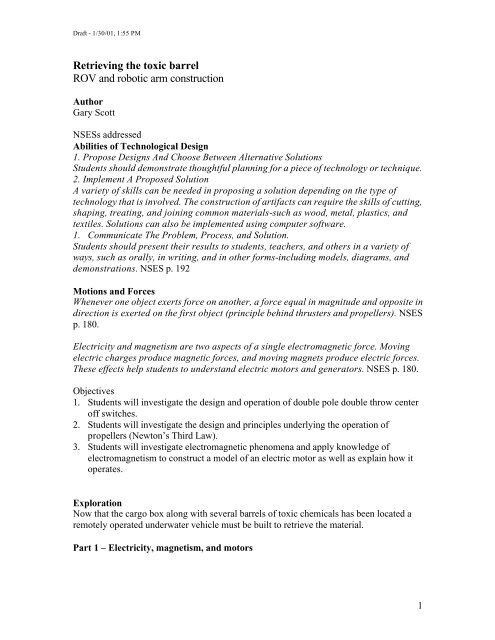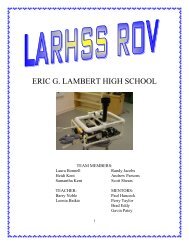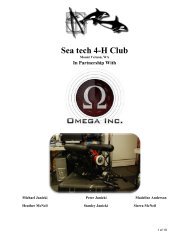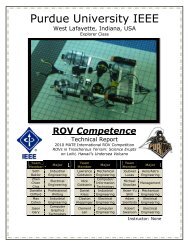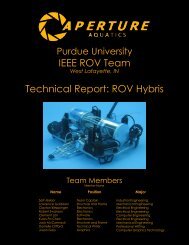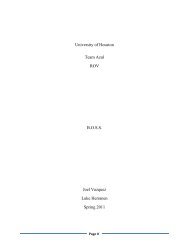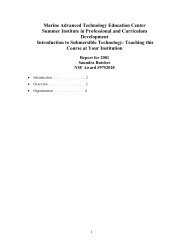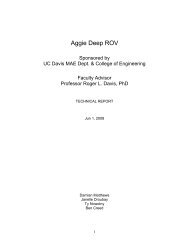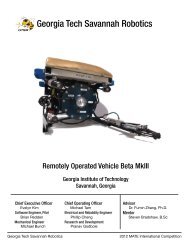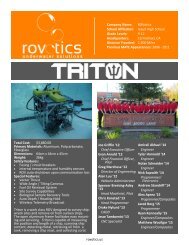You also want an ePaper? Increase the reach of your titles
YUMPU automatically turns print PDFs into web optimized ePapers that Google loves.
Draft - 1/30/01, 1:55 PM<br />
Retrieving the toxic barrel<br />
<strong>ROV</strong> and robotic arm construction<br />
Author<br />
Gary Scott<br />
NSESs addressed<br />
Abilities of Technological Design<br />
1. Propose Designs And Choose Between Alternative Solutions<br />
Students should demonstrate thoughtful planning for a piece of technology or technique.<br />
2. Implement A Proposed Solution<br />
A variety of skills can be needed in proposing a solution depending on the type of<br />
technology that is involved. The construction of artifacts can require the skills of cutting,<br />
shaping, treating, and joining common materials-such as wood, metal, plastics, and<br />
textiles. Solutions can also be implemented using computer software.<br />
1. Communicate The Problem, Process, and Solution.<br />
Students should present their results to students, teachers, and others in a variety of<br />
ways, such as orally, in writing, and in other forms-including models, diagrams, and<br />
demonstrations. NSES p. 192<br />
Motions and Forces<br />
Whenever one object exerts force on another, a force equal in magnitude and opposite in<br />
direction is exerted on the first object (principle behind thrusters and propellers). NSES<br />
p. 180.<br />
Electricity and magnetism are two aspects of a single electromagnetic force. Moving<br />
electric charges produce magnetic forces, and moving magnets produce electric forces.<br />
These effects help students to understand electric motors and generators. NSES p. 180.<br />
Objectives<br />
1. Students will investigate the design and operation of double pole double throw center<br />
off switches.<br />
2. Students will investigate the design and principles underlying the operation of<br />
propellers (Newton’s Third Law).<br />
3. Students will investigate electromagnetic phenomena and apply knowledge of<br />
electromagnetism to construct a model of an electric motor as well as explain how it<br />
operates.<br />
Exploration<br />
Now that the cargo box along with several barrels of toxic chemicals has been located a<br />
remotely operated underwater vehicle must be built to retrieve the material.<br />
Part 1 – Electricity, magnetism, and motors<br />
1
Draft - 1/30/01, 1:55 PM<br />
Compass construction<br />
What is a compass and how does it work? In this activity you will build a compass and<br />
save it for the next section when you construct a motor.<br />
Materials<br />
3 magnets with holes in the center<br />
1 straw<br />
2 pieces of #22 wire, 20 cm long<br />
1 plastic cup<br />
1 compass<br />
Procedure<br />
1. Bend the two #22 wires in half around your index finger.<br />
2. Arrange the two magnets so that they stick together side by side, as shown. Push the<br />
open ends of one wire one third of the way through the hole in the center of one of the<br />
magnets. Now do the same to the other magnet with the other wire.<br />
2
Draft - 1/30/01, 1:55 PM<br />
3. Without removing the wire, separate the two magnets. Pull apart the open ends of the<br />
wire and wrap each end aroun the long sides of the magnet. Bend the looped end up<br />
over the top and let it project forward. Now do the same to the other magnet.<br />
3
Draft - 1/30/01, 1:55 PM<br />
4. Check to see if the sides of the magnets away from theloop will attrat each other. If<br />
they repel, go back to Step 2, remove the wire from one of the magnets, turn it over,<br />
and rewire it. The magnets should stick together, with the looped ends pointing in<br />
opposite directions.<br />
5. Insert the looped ends into the ends of the straw.<br />
6. Balance the straw on your finger and push the pin down through the straw at the place<br />
where it balances. The tip of the pin should project about 5mm below the bottom of<br />
the straw. Do not make more than one or two holes in the straw of the pin will slip.<br />
4
Draft - 1/30/01, 1:55 PM<br />
7. Balance the straw across the top of the inverted plastic cup. Do not push the pin into<br />
the plastic up. Adjust the balance of the straw compass by pulling out or pushing in<br />
the magnets at the ends of the straw a little bit, as needed.<br />
After you have balanced your compass, test to see if it points in only one direction when<br />
you release it from different positions. Get a small compass from your teacher and<br />
compare the direction it points to the direction that yours points. Does your compass have<br />
a north and south pole? If so, place a small dot on the straw to show its north pole. Bring<br />
the small compass close to your compass’ north pole. Which end of the small compass<br />
(the north seeking or south seeking) is attracted to your compass’ north seeking end?<br />
Using your extra magnet find a way to make your straw compass rotate. How can you<br />
speed up or slow down the compass’ rate of rotation. Explain how you accomplished a<br />
change in rotation speed.<br />
Predict the effect decreasing the length of the straw on the rotation rate. Predict the effect<br />
of using two or more magnets to effect the rate of rotation.<br />
5
Draft - 1/30/01, 1:55 PM<br />
Building a motor<br />
Do you know what makes an electric motor work? In this activity you will build a simple<br />
electric motor.<br />
Materials<br />
Straw compass built in last activity<br />
1 coil of #21 coated hook-up wire, 1.5 m long<br />
1 plastic cup<br />
1 piece of #22 coated hook-up wire, 20 cm long<br />
1 battery and battery holder<br />
1 switch<br />
2 # 16 rubber bands<br />
Procedure<br />
1. Using the piece of wire that is 1.5 m long, coil it around three of your fingers. Attach<br />
the coils to the side of the inverted plastic cup with the two rubber bands. Connect the<br />
coil to the battery and the switch. With the 20 cm long wire connect the switch and<br />
the battery. Position the coil two finger widths away from the north pole of the straw<br />
compass.<br />
2. What effect does the coil have on the magnet when the switch is off?<br />
3. Turn the switch on so that electricity will run through the coil. Is the north magnet<br />
attracted or repelled by the coil?<br />
4. Now, position the south pole magnet next to the coil. Predict what will happen when<br />
you turn the switch on.<br />
5. Make the straw compass a motor by causing it to spin continuusly in one direction by<br />
just turning the switch on or off at the right time. Remember which end is being<br />
attracted to the coil and which end is being repelled.<br />
Building a spinning coil motor<br />
Materials<br />
6
Draft - 1/30/01, 1:55 PM<br />
2 pieces of #20 bare copper wire, each 20 cm long<br />
2 #16 rubber bands<br />
1 plastic cup<br />
3 #22 wires with alligator clips on each end<br />
1 battery and battery holder<br />
1 switch<br />
1 piece of #28 enameled copper wire, 65 cm long<br />
1 piece of sandpaper, 5 cm square<br />
1 flexible magnet with hole in the center<br />
Procedure<br />
1. Start by making a loop in the middle of each of the two bare copper wires. Wrap them<br />
around a pencil then slide the loop off the pencil.<br />
2. Use the two rubber bands to attach the bare copper wire to the plastic cup.<br />
3. Clamp an alligator clip to one end of each of the bare copper wires.<br />
4. Hook up the rest of the circuit by connecting the battery and the switch to the alligator<br />
clips.<br />
7
Draft - 1/30/01, 1:55 PM<br />
5. Next, begin to make the moving coil from the #28 wire. The wire has a thin coating<br />
of insulation on it called enamel, so you will need to sand off the insulation at the<br />
ends. This is so the electricity can flow from the bare copper wire through the thin<br />
wire to the other bare copper wire. Sand about one finger-length of insulation gently<br />
off each end of the wire. You can do this by folding the sandpaper in half and pulling<br />
the ends of the wire carefully between the two sides of the sandpaper.<br />
6. Wrap the wire around the battery several times. Leave the bare ends sticking out of<br />
the coil. Slip the coiled wire off the battery. Wrap the bare ends three or four times<br />
around the coil to hold it in a circular shape. Then bend the ends of the wire so that<br />
they stick straight out on opposite sides of the coil.<br />
8
Draft - 1/30/01, 1:55 PM<br />
7. Place the ends of the coil through the loops in the bare wire on each side of the cup. If<br />
necessary, bend the coil and adjust the loops so that the coil can spin freely, without<br />
hitting anything.<br />
9
Draft - 1/30/01, 1:55 PM<br />
8. Place a magnet on the top of the inverted cup, underneath the coil. Turn the switch on<br />
and blow gently on the coil to help it get started. If the coil will not spin continuously,<br />
try adjusting the position of the magnet, the distance of the coil to the magnet, or<br />
bending the wires.<br />
Now that you have found out how to make the motor work answer the questions below.<br />
i. Where do you think the electricity flows in this circuit? Draw a picture to help you<br />
explain<br />
ii. Do you think the coil is magnetized? Describe the evidence for your answer. Make a<br />
drawing of your coil showing where the north and south are located.<br />
iii. How can you make the coil spin faster or change direction. Explain how you<br />
accomplished these two tasks.<br />
iv. How does this motor compare to the spinning compass motor? How are they alike?<br />
How are they different?<br />
Commercially made electric motors<br />
Electric motors are found in many everyday devices such as refrigerators, VCRs, and<br />
many toys. In this activity you will disassemble a commercially made motor and explain<br />
how it operates based on the simple models you have previously constructed.<br />
Materials<br />
Electric motor from last activity<br />
Commercial electric motor<br />
Steel nail<br />
2 magnets<br />
10
Draft - 1/30/01, 1:55 PM<br />
2 strands of #20 hook-up wire, 30 cm long each<br />
Procedure<br />
Based on the electric motor you created, predict what kinds of parts you should find<br />
inside of the commercially made electric motor.<br />
1. To take the motor apart begin by using a nail to slowly bend the metal tabs away from<br />
the plastic end of the motor as shown below.<br />
2. Hold the motor case with one hand and push carefully on the motor shaft with one<br />
finger.<br />
3. The plastic cap will come off and you will be able to take the motor shaft out of the<br />
case.<br />
11
Draft - 1/30/01, 1:55 PM<br />
4. Separate the motor into three pieces as shown below.<br />
5. Look closely at each of the three parts. Think about how they were connected when<br />
the motor was assembled. Explain how the parts are similar to the part of the motor<br />
you made.<br />
6. All the parts of the motor help in some way to make the motor run. Look at your<br />
motor and figures above. Explain what you think the different parts of the motor do.<br />
12
Draft - 1/30/01, 1:55 PM<br />
How does a motor work?<br />
Get your materials from the section on building a motor.<br />
1. Take one of the bare copper wires off of the plastic cup. Slide the ends of the<br />
remaining bare copper wire so that the loop is directly above the center of the cup.<br />
13
Draft - 1/30/01, 1:55 PM<br />
2. Slide the two pieces of hook-up wire under the rubber bands and bend apart the bare<br />
ends that are protruding beyond the tape so that they make a "V”.<br />
3. Connect to the battery holder and switch the ends of the hook-up wire that are no<br />
taped together. Bend the wires so that the cup will not tip over when you let it sit<br />
without hold it. This will be your test stand.<br />
4. Place the armature of the motor you took apart on the test stand. Bend the wires so<br />
that the armature fits and will not fall off. Can you figure out which end of the<br />
armature needs to rest in the “V”? Screw the switch down so that electricity will flow<br />
throught the circuit. Hold a magnet near the armature. Can you make armature spin?<br />
5. Experiment with the two magnets to find the location that makes the motor spin the<br />
fastest. Does it matter how close the magnets are to the armature? Does it matter<br />
which pole of the magnet faces the armature?<br />
6. Experiment to find as many ways as possible to make themotor turn slowly. What are<br />
the different things you can do to make the motor slow down?<br />
7. Experiment to find ways to make the motor change direction. How many ways can<br />
you find?<br />
14
Draft - 1/30/01, 1:55 PM<br />
8. Think about how the parts of the motor fit together. Look at the diagrams and try to<br />
put your motor back together carefully. The numbers indicate the sequence in which<br />
the parts are to be assembled.<br />
Part 2 – double pole double throw switch design<br />
How do switches work? Your task is figure out how a double pole double throw switch<br />
works and make a diagram of the internal design.<br />
15
Draft - 1/30/01, 1:55 PM<br />
Materials<br />
9. 12 volt lantern battery<br />
10. One double pole double throw (DPDT) center off switch rated at 3 amps.<br />
11. One electric motor<br />
12. 18 or 22 gauge hookup wire<br />
13. One propeller<br />
Procedure<br />
7. Connect the battery to the middle terminals of the DPDT switch.<br />
8. Connect the wires from the motor’s terminals to one end of the DPDT switch. Put a<br />
propeller on the long shaft of the motor.<br />
9. Trace the pathway of the connections from the positive terminal of the battery to the<br />
motor.<br />
10. Trace the pathway of the connections from the negative terminal of the battery to the<br />
motor.<br />
Which way should you push the lever on the switch to turn the motor on? Push the<br />
switch’s lever to turn the motor on. Which way did the propeller turn?<br />
How do you think the inside of the switch is designed so that current is transferred from<br />
the middle terminals of the switch to the end terminals of the switch? Draw a diagram<br />
that shows what the internal wiring of the switch looks like and show it to your instructor.<br />
Using two pieces of wire how could modify your design so that flippin the switch’s lever<br />
in the opposite direction would send current to the motor and cause the propeller to turn<br />
in the opposite direction? After you solve this problem, draw another diagram that shows<br />
what the internal wiring of the switch looks like and show it to your instructor.<br />
Drew – I need a graphic showing the inside of the switch from the top and side.<br />
Part 3 – propeller driven vehicle design<br />
Your first task is to figure out how a propeller moves a vehicle. To do this you will need<br />
a propeller, electric motor, wire, and the 6 volt lantern battery. After you connect these<br />
components place the propeller and motor so the propeller is closest to you. Now,<br />
connect the motor wires to the battery and notice which way the propeller turns. If the<br />
propeller turns clockwise reverse the way the wires are connected to the battery.<br />
Example, if the black wire is connected to the negative terminal, connect it to the positive<br />
terminal. Disconnect one of the wires, set the propeller and motor down, and get your<br />
paper and pencil so you can answer the following questions.<br />
Predictions<br />
Write down your predictions in complete sentences to the following questions.<br />
i. If the propeller rotates counterclockwise which way will the right blade push the<br />
air?<br />
ii. If the propeller rotates counterclockwise, which way will the left blade push the air?<br />
16
Draft - 1/30/01, 1:55 PM<br />
Testing your predictions<br />
Now connect the wires to the battery so the propeller rotates counterclockwise. Hold a<br />
piece of paper about 6 inches from the backside of the propeller and notice which way the<br />
paper moves.<br />
iii. Why is the paper moving? Answer this question using the following words:<br />
propeller, pushes, air, paper.<br />
Your answer to question three needs some more thought. The propeller is pushing the air<br />
backwards (towards the motor). If the propeller and motor were mounted on a boat or<br />
airplane, which way would the boat or plane move?<br />
Reverse the way the wires are connected to the battery. The propeller should be turning<br />
clockwise.<br />
Predictions<br />
Write down your predictions in complete sentences to the following questions.<br />
iv. If the propeller rotates clockwise which way will the right blade push the air?<br />
v. If the propeller rotates clockwise, which way will the left blade push the air?<br />
Testing your predictions<br />
Now connect the wires to the battery so the propeller rotates counterclockwise. Hold a<br />
piece of paper about 6 inches from the backside of the propeller and notice which way the<br />
paper moves.<br />
vi. Why is the paper moving? Answer this question using the following words:<br />
propeller, pushes, air, paper.<br />
Your answer to question three needs some more thought. The propeller is pushing the air<br />
backwards (towards the motor). If the propeller and motor were mounted on a boat or<br />
airplane, which way would the boat or plane move?<br />
Concept formation<br />
4. Make a diagram to illustrate how a propeller moves a vehicle forwards and<br />
backwards. Use arrows to show the direction the propeller forces air to move and in<br />
turn the direction the air molecules push on the propeller.<br />
5. Using your diagram, write out an explaination of how a propeller moves a vehicle<br />
forwards and backwards.<br />
6. Now think about jet airplanes, rocketships, and squid. All three move by jet<br />
propulsion, that is, in all three cases the propulsion system forces molecules to move<br />
in one direction and the object then moves in the opposite direction. This phenomena<br />
was described by Sir Isaac Newton and is often referred to as Newton’s Third Law of<br />
Motion. In Newton’s own words, to every action there is always opposed an equal<br />
reaction. The following sentence refers to Newton’s Third Law but has blanks for you<br />
to fill in to make it complete.<br />
17
Draft - 1/30/01, 1:55 PM<br />
Two objects interact such that for every force exerted on one, there is an _____<br />
and _____ directed force exerted on the other.<br />
Concept application<br />
Using your knowledge of motor operated vehicles (such as boats and planes)<br />
imagination, and the materials supplied in your kit, design a remotely operated vehicle<br />
(<strong>ROV</strong>) that can move forward, backward, right, left, up and down in the testing tank. You<br />
should make a careful drawing for your design and include the position of the motors<br />
with propellers and the body of the <strong>ROV</strong>. Indicate in your drawing which direction the<br />
<strong>ROV</strong> will go when the propellers are turning clockwise and counterclockwise.<br />
<strong>ROV</strong> Construction<br />
Objectives<br />
1. Students will construct a remotely operated vehicle that can pick up a ‘barrel of toxic<br />
material’ in a tank of water five feet deep.<br />
2. Density – air weight, water weight<br />
3. Displacement, Archimedes principle<br />
4. Pressure<br />
5. Fluid dynamics<br />
Exploration<br />
Part 1 - Constructing the frame<br />
Use your drawing from the concept application problem and PVC parts to construct an<br />
<strong>ROV</strong> frame.<br />
Where will you mount your motors so the <strong>ROV</strong> can go left, right, up and down?<br />
Part 2 - Wiring the switches in the control box<br />
1. Drill holes in your control box far enough apart so the switches won’t interfere with<br />
one another. Determine which holes you will use for the left, right, and up/down<br />
thruster wires. The holes should be just large enough for the switch shaft to fit<br />
through.<br />
2. Solder the switches as shown in the diagram before you mount them to the control<br />
box. After soldering a switch put labels on the wires (e.g. left, right, up/down) so that<br />
you know which wires to connect to the tether coming from the thrusters.<br />
3. Secure the switches to the control box.<br />
4. Connect the wires from the switches to the tether from the thrusters.<br />
18
Draft - 1/30/01, 1:55 PM<br />
Part 3 – Waterproofing the thrusters<br />
Heat up toilet seat wax before you start this procedure. The wax should be just hot<br />
enough to pour easily. You will use it step 7.<br />
1. Drill a hole in the top of the film canister so you can thread the end of the 20’ wire<br />
through the hole.<br />
2. Tie a knot in the wire leaving just enough wire so you can solder the ends to the<br />
motor.<br />
3. Solder the ends of the motor’s terminals to the 20’ tether carrying power to the motor.<br />
Make sure the knot can fit inside the canister with the lid on.<br />
4. Cover the holes on the sides of the motor with electrical tape by wrapping electrical<br />
tape around the motor two times.<br />
5. Use hot glue to seal the holes in the top and bottom of the motor. Be careful to keep<br />
the hot glue from dripping inside the motor.<br />
6. Drill a hole in the inside of the film canister slightly larger than the diameter of the<br />
motor shaft. For most shafts, a hole about 3/32” in diameter will do.<br />
7. Place a thick dab of petroleum jelly on the shaft and bottom of the motor.<br />
8. Place the motor inside the film canister and set them on the block of wood with the<br />
hole in it. The shaft of the motor should fit snugly in the blocks hole.<br />
9. Pour wax into the canister until the motor is entirely covered but leave enough space<br />
so the knot can fit in the canister with the lid on.<br />
10. After the wax has hardened connect the other end of the 20’ tether to a battery to<br />
make sure the motors are still functional.<br />
11. You will glue propellers on the thrusters after the thrusters are secured to the <strong>ROV</strong><br />
frame.<br />
19
Draft - 1/30/01, 1:55 PM<br />
Part 4 - Mounting the thrusters to the frame and testing<br />
1. Mount your thrusters on the <strong>ROV</strong> so that it can go forwards, backwards, up and<br />
down.<br />
2. After mounting your motors place the <strong>ROV</strong> in the tank and notice how it is positioned<br />
in the water. Does it float or sink?<br />
3. If it sinks, which material in your kit should you use for buoyancy?<br />
4. Where should the buoyancy material be placed on the <strong>ROV</strong>?<br />
5. The uppermost part of the <strong>ROV</strong> should be positioned just below the surface of the<br />
water (about 5 cm), if it is not, what do you think you should do? Look at the parts in<br />
your kit, do you see anything that may help you to solve this problem?<br />
20


